H&G Q&A: Insect galls, crape myrtle growth and Japanese beetles
Published 12:00 am Saturday, June 25, 2022
High humidity and afternoon showers create the perfect environment for a multitude of problems for home gardeners. While some are having difficulty with insects and diseases, others seem to be avoiding normal early summer problems. Count your blessings as insects and diseases ebb and flow during the growing season. Below are a few questions I’ve received over the past few days.
Question: I have a very large pecan tree and the leaves are covered with bumps. I’ve never seen anything like this on my tree. What is this? Will it kill the tree?
Answer: The bumps you’re seeing on the leaves are insect galls. It’s caused by a minute insect, pecan phylloxera that is similar in appearance to an aphid. The bumps will eventually turn brown and may cause some of the infested leaves to fall. The insect is more of a curiosity than a serious problem. There is no recommended control for the insect on large pecan trees. Go to http://entoplp.okstate.edu/ddd/insects/phylloxera.htm
Question: We have crape myrtles that have new growth emerging from the base of the tree. Is now a good time to prune them out? Is there any way to keep them from coming back?
Answer: The new growth or water sprouts often referred to as suckers. These can be pruned out from around the tree now. Be sure to prune them as close to the trunk as possible and do not leave a stub. If you leave a stub, the water sprouts will quickly reappear.
Question: There is a small evergreen shrub at one of my friends’ home that has blooms very similar to a dogwood. They are much smaller and are blooming now. Can you tell me what the name of this shrub?
Answer: The plant you referring to is an evergreen dogwood tree, Cornus Angustana ‘Elsbry’ Empress of China. The small tree can produce up to 150 creamy white blooms per branch in late spring. The small tree can reach a height of 12-15 feet and has survived very well at their location for a number of years. Go to https://jcra.ncsu.edu/horticulture/our-plants/results-by-name-serial-number.php?serial=110926 for more detailed information.
Question: I have a problem with Japanese beetles. What can I do to eliminate them?
Answer: These beetles have a wide host range-feeding on over 275 different types of trees, shrubs and vegetable plants. Insecticides containing Sevin can be applied as a dust or a liquid for immediate control; however, Sevin-based insecticides are highly discouraged due to toxicity to pollinators, especially honey bees. Japanese beetle traps can be implemented as an alternative control method implementing a pheromone (sex attractant) attracting the insect into the trap. Research has shown that Japanese beetles are also attracted to bright colors, especially “John Deere” yellow. Unfortunately, the traps attract more beetles to the very plants you are trying to protect.
Hand picking the beetles is another method of control if the beetle population is not too large. Fortunately, most damaged plants recover soon after the initial invasion. Go to https://content.ces.ncsu.edu/japanese-beetle-1 for more detailed information.
Darrell Blackwelder is the retired horticulture agent and director with the North Carolina Cooperative Extension Service in Rowan County. Contact him at deblackw@ncsu.edu .





